Every year, water professionals from across the country come together to engage in the United States Water Week. During this event, elected officials, and policymakers work to ensure all communities have access to safe, reliable, and affordable drinking water and clean water. Much of the main discussions surround increasing infrastructure investments, addressing water affordability, and supporting water research and development. Across the United States, increasing costs of water and a strict focus on contaminants in the water supply are needing solutions that are safe and resilient.
Faced with aging infrastructure in both private and public sectors and changing climate trends, water resilience is facing an all-time instability. Inflation will reach water if it has not already and will affect many communities from metropolitan areas to rural communities. Barclays estimates the true cost of water is three to five times higher than what companies and consumers are currently paying. During the peak of the COVID-19 pandemic, many low-income customers struggled to afford the rising costs of water. Some regions may already be facing these price increases, while others may still be stable on prices. However, no region is safe when facing aging infrastructure and changing climates, but the overall result is the increased cost of water for customers. The United States’ Environmental Protection Agency (EPA) estimates that $750 billion over the next 20 years is required to maintain our current service levels in drinking water and wastewater.
The increasing costs have a positive effect too because of the increasing investments. Over 16,000 municipal wastewater treatment facilities serve 75 percent of the United States population. Nearly two million workers in the United States are tied to water utilities. That stretches to your cost of water because “[e]very $1 on improving the country’s water infrastructure generates $6 in returns, and every job created in the water sector supports the creation of another 3.68 jobs for the national economy” (“Social Shareables”). The stable water rates and created jobs are a benefit to the community, but part of the rising costs is the focus on the contaminants in the systems from years of use and pollutants.
For United States Water Week 2022, there is a key focus on per- and polyfluoroalkyl substances (PFAS) due to their persistence in water, soil, and air. The synthetic substances have been used commercially for decades, but public awareness is growing due to their potential public health and environmental impacts. Local municipalities do not produce PFAS but receive “these chemicals through the raw influent that arrives at the treatment plant” supplied by domestic, industrial, and commercial water (“Clean Water Advocacy Asks”). The EPA has recommendations for PFAS, but there are not federal regulations. This leaves states and local communities to implement their own action plans.
Along with PFAS, local publicly owned treatment works (POTWs) face groundwater and surface water contaminants on a regular basis. Groundwater contaminants can be physical, chemical, bacteriological, or radioactive, and POTWs use robust solutions depending on raw water quality, treatment objectives, and operational needs. Surface water requires the removal of suspended or dissolved compounds and pathogens and viruses. Throughout the COVID-19 pandemic, there have been often stories about the level of the coronavirus in a city’s POTW. However, the water is treated before being released for commercial, industrial, and domestic use with contaminants removed. The water coming into the POTWs will have continued contaminants based on the use, facility, water source, and other, and facilities can limit their stress on POTWs by treating their discharge water.
Industrial facilities are facing rising costs passed on from local POTWs along with rising costs of equipment and services. Facilities are paying for water they receive and the water they release. They can reduce water used via water reuse and reclamation to meet sustainability goals and National Pollutant Discharge Elimination System (NPDES) permit requirements. Chemicals, equipment systems, and automation can help a facility stay up to date and be proactive before issues arise. These will also affect what type of treated water is sent back to the POTW.
To help mitigate these costs, water reuse is a good option to improve the costs of doing business and allows the city to keep domestic water prices reasonable for the local community. Water reuse is just reusing water that you have already used once, and industrial water reuse usually involves some treatment. More than ever with water scarcity affecting regions of the United States, water reuse can decrease water costs, reduce amount of water used, and limit a facility’s impact on the environment, which will have a chain reaction. Water reuse is helping facilities meet source water constraints, tightening regulations, and corporate initiatives. Water reuse is a solution for the future to fight rising costs.
This Water Week 2022, focus on the water in your lives from domestic to industrial. Rising costs of water will be affecting your facility and home for years to come as inflation rates, changing climate trends, aging infrastructure, and more. Across the United States, issues are rising from increasing costs of water and a tighter focus on contaminants in the water supply are needing solutions that are safe and resilient. As your long-term partner, Kurita America harmonizes humanity and technology through water throughout your facility, including chemical, mechanical, and operational, all to deliver optimal results and conserve natural resources for a better, more sustainable world.
References
About Water Week 2022. Water Week 2022. (n.d.). https://www.waterweek.us/#about-water-week
Calculating the True Cost of Water for the Consumer Staples Sector. Barclays. (2021, July 20). https://www.cib.barclays/our-insights/3-point-perspective/calculating-the-true-cost-of-water-for-the-consumer-staples-sector.html
Clean Water Advocacy Asks. NACWA. (2021). https://www.waterweek.us/wp-content/uploads/2021/04/PFAS-Fact-Sheet-2021.pdf
Sample Social Media Posts. Water Week 2022. (n.d.). https://www.waterweek.us/wp-content/uploads/2022/04/socialmedia-posts22.pdf
Social Shareables. Water Week 2022. (n.d.). https://www.waterweek.us/social-shareables/

